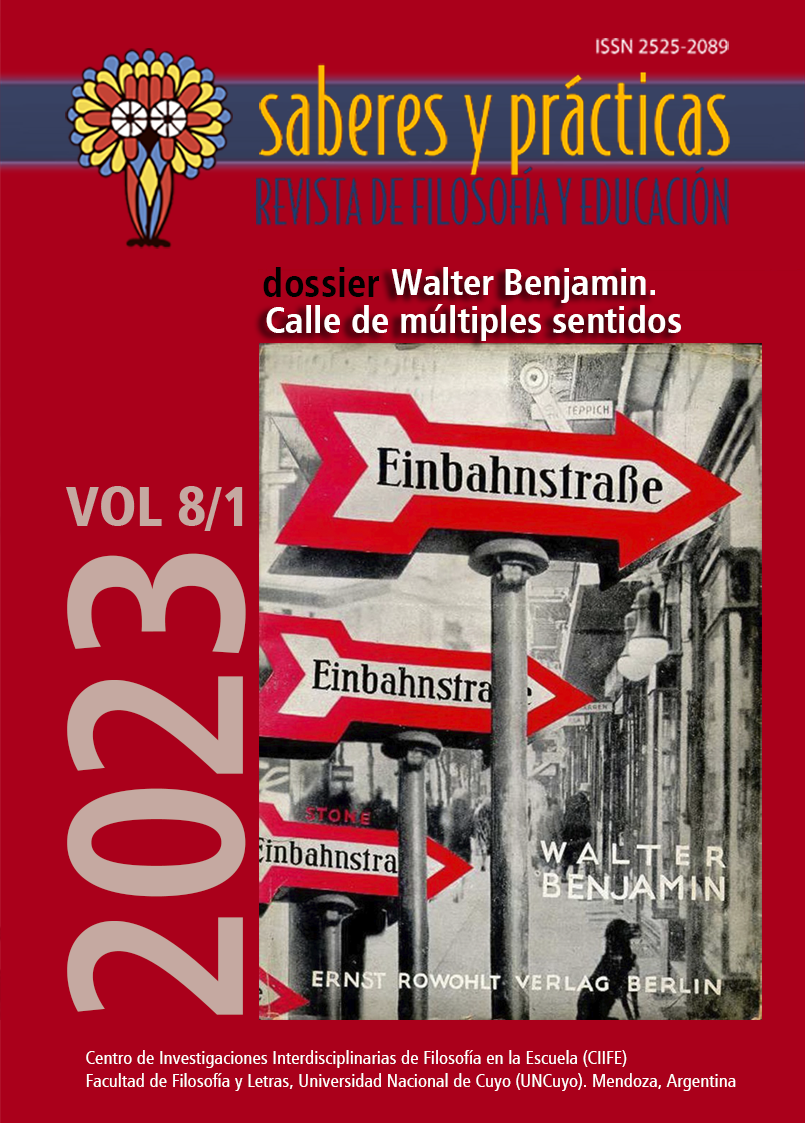The Figure of Brooder [Grübler] and the Non-Human in Walter Benjamin. A Materialist Approximation to the Activity of Thought
DOI:
https://doi.org/10.48162/rev.36.102Keywords:
Baudelaire, allegory, flâneur, multitude, massAbstract
In this paper, we examine Benjamin’s use of the figure of the brooder [Grübler] to characterize Baudelaire in "Central Park" and in the convolute J dedicated to the poet in the Arcades Project. While previous studies of the brooder in the German-Jewish philosopher's work have focused on melancholic knowledge and allegory in the Origin of German Tragic Drama, we seek to demonstrate the shifts that occur in Benjamin's approach to brooding in his analysis of Baudelaire. We argue that the activity of brooding should be understood not only in relation to allegory but also to flânerie. Our paper proposes a materialist conception of thought that unfolds around brooding, in which non-human motives are embodied and in which takes place an articulation between theory and practice, or between thought and action, through the complementarity between the attitude of the allegorist and the flâneur. Therefore, with the figure of the brooder, Benjamin not only disputes the philosophical tradition
dominant of thought as a contemplative human activity, but also its critical-political potential to account for the concrete phenomena of his time in a horizon that orates the limits of the human.
Downloads
References
Adorno, T. W. (1962). Caracterización de Walter Benjamin (pp. 151-160). en Prismas. La crítica de la cultura y la sociedad. Trad. M. Sacristán. Ariel.
Agamben, G. (2016). On Benjamin’s Baudelaire (217-230). En Dickinson, C. y Symons, S. (Eds.). Walter Benjamin and Theology. Trad. A. Kotsko. Fordham University Press.
Baudelaire, C. (2013). Las flores del mal. Trad. A. Martínez Sarrión. Madrid; Alianza.
Benjamin, W. (1991). Gesammelte Schriften. Bände I-VII. Tiedemann, R. y Schweppenhäuser, H. (Eds.). Suhrkamp.
Benjamin, W. (2005). Libro de los Pasajes. Tiedemann, R. y Schweppehnhäuser, H. (Eds.). Trad. L. Fernández Castañeda, I. Herrera y F. Guerrero. Akal.
Benjamin, W. (2006). Obras, Libro I, vol. 1. Tiedemann, R. y Schweppenhäuser, H. (Eds.). Trad. A. Brotons Muñoz. Abada.
Benjamin, W. (2008). Obras, libro I, vol. 2. Tiedemann, R. y Schwepenhäuser, H. (Eds.). Trad. A. Brotons Muñoz. Abada.
Benjamin, W. (2009). Obras, libro II, vol. 2. Tiedemann, R. y Schwepenhäuser, H. (Eds.). Trad. J. Navarro Pérez. Abada.
Benjamin, W. (2010). Obras, libro IV, vol. 1. Tiedemann, R. y Schweppenhäuser, H. (Eds.). Trad. J. Barja, F. Duque y F. Guerrero. Abada.
Benjamin, W. (2012). El París de Baudelaire. Trad. M. Dimópulos. Eterna cadencia.
Benjamin, W. (2013a). Obras, libro V, vol. 1. Tiedemann, R. y Schweppenhäuser, H. (Eds.). Trad. J. Barja. Abada.
Benjamin. W. (2013b). Baudelaire. Agamben, G., Chitussi, B. y Härle, C.-C. (Eds.). Trad. P. Charbonneau. La fabrique.
Benjamin, W. (2015). Obras, libro V, vol. 2. Tiedemann, R. y Schweppenhäuser, H. (Eds.). Trad. J. Barja. Abada.
Buck-Morss, S. (2001). Dialéctica de la mirada. Walter Benjamin y el proyecto de los Pasajes. Trad. N. Rabotnikof. La balsa de medusa.
Buck-Morss, S. (2005). Walter Benjamin, escritor revolucionario. Trad. M. López Seoane. Interzona.
Di Pego, A. (2022). Hacia una política de lo no-humano [Unmensch]: Walter Benjamin y Paul Scheerbart. Anthropology & Materialism. A Journal of Social Research, II. https://doi.org/10.4000/am.1685
Fernández Gijón, E. (1990). Walter Benjamin. Iluminación mística e iluminación profana. Universidad de Valladolid.
Galende, F. (2009). Walter Benjamin y la destrucción. Metales pesados.
Gilloch, G. (2002). Walter Benjamin. Critical Constellations. Polity Press.
Hanssen, B. (2000). Walter Benjamin’s Other History. Of Stones, Animals, Human Beings, and Angels. University of California Press.
Hoffmann, E.T.A. (2007). “El mirador del primo”. En Cuentos. A. Pérez y C. Fortea (Eds.). Cátedra.
Lindner, B. (2014). Alegoría. En Opitz, M. y Wizisla, E. (Eds). Conceptos de Walter Benjamin (pp. 17-82). M. Belforte y M. Vedda (ed. castellana). Las cuarenta.
Maura, E. (2013). Las teorías críticas de Walter Benjamin. Bellaterra.
Missac, P. (1997). Walter Benjamin: de un siglo al otro. Trad. B. E. Anastasi de Lonné. Gedisa.
Naishtat, F. (2022). La Idea de Historia Natural (Naturgeschichte) y la noción de lo no-humano (Unmensch) en el pensamiento de Walter Benjamin. Actas IV Jornadas Walter Benjamin. De la crítica de lo humano a lo Unmensch (no-humano). file:///D:/Usuario/Downloads/Naishtat%20(2).pdf
Poe, Edgar Allan (1998): El hombre de la multitud (pp. 245-256). En Cuentos 1. Trad. J. Cortázar. Alianza.
Santner, E. L. (2006). On Creaturely Life. Rilke, Benjamin, Sebald. The University of Chicago Press.
Taccetta, Natalia (2019): La experiencia de la modernidad. Shock y melancolía en Walter Benjamin. Las torres de Lucca. Revista internacional de filosofía política, 8(15),107-133.
Weidner, D. (2010). Kreatürlichkeit. Benjamin Trauerspielbuch und das Leben des Barock (120-138). En Weidner, D. (Ed.). Profanes Leben. Walter Benjamins Dialektik der Säkularisierung. Suhrkamp.
Weigel, S. (2013). Walter Benjamin. Images, the Creaturely, and the Holy. Trad. C. Truscott Smith. Stanford University Press.
Woollands, S. (2016). El concepto de melancolía y su impronta crítica en el Trauerspielbuch de Walter Benjamin. (Tesis de licenciatura en Filosofía. Universidad Nacional de La Plata). https://www.memoria.fahce.unlp.edu.ar/tesis/te.1505/te.1505.pdf
Published
How to Cite
Issue
Section
License
Copyright (c) 2023 Anabella Di Pego
This work is licensed under a Creative Commons Attribution-NonCommercial-ShareAlike 2.5 Argentina License.





















